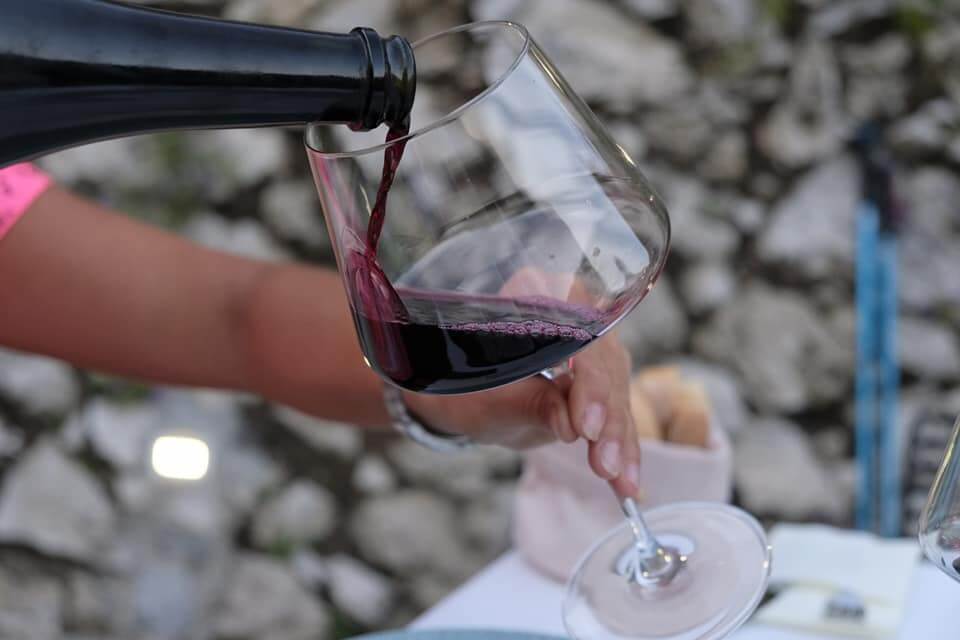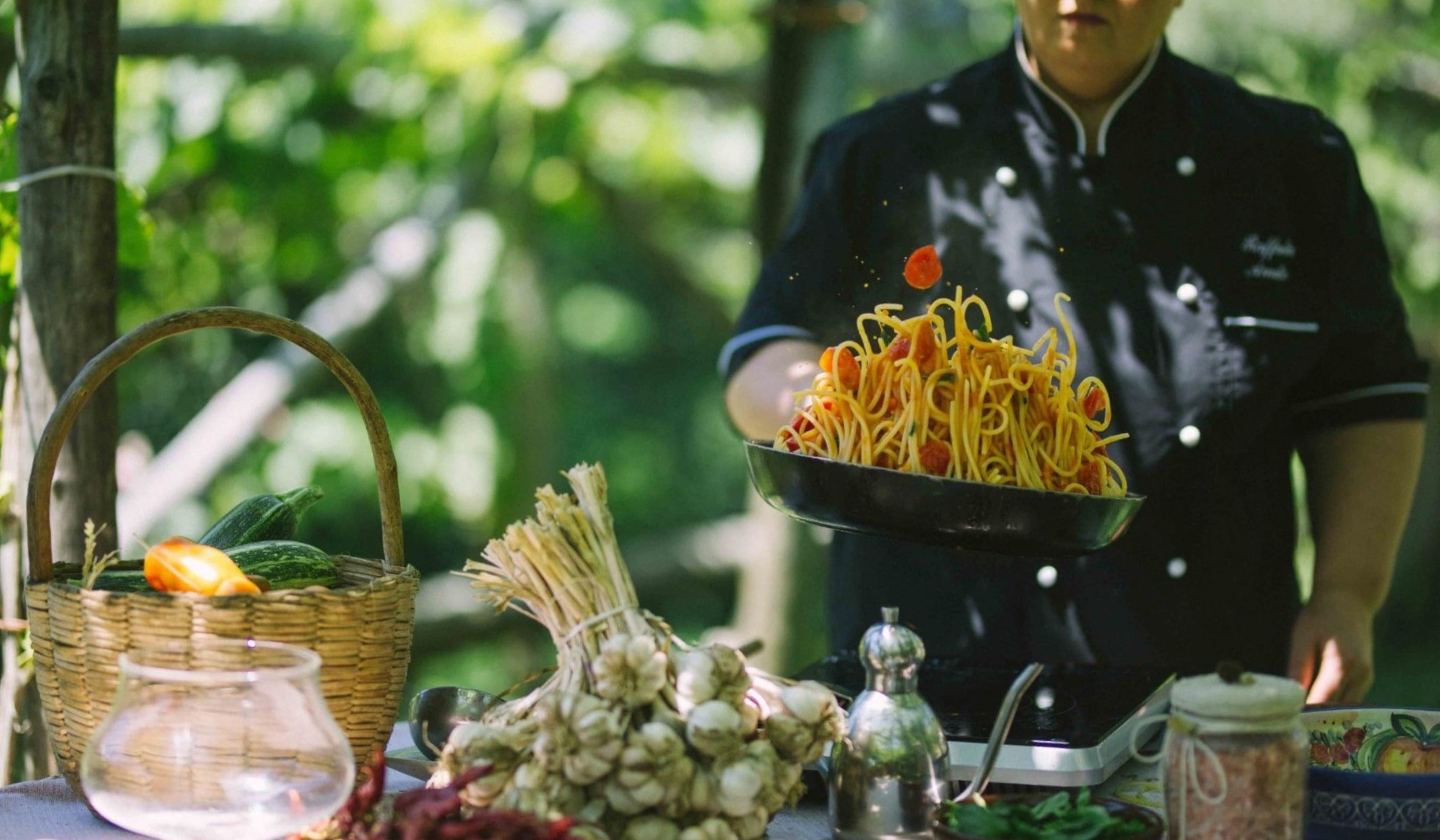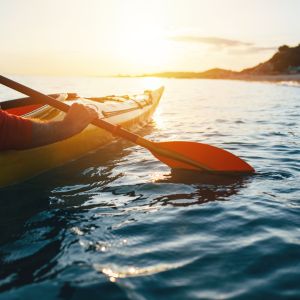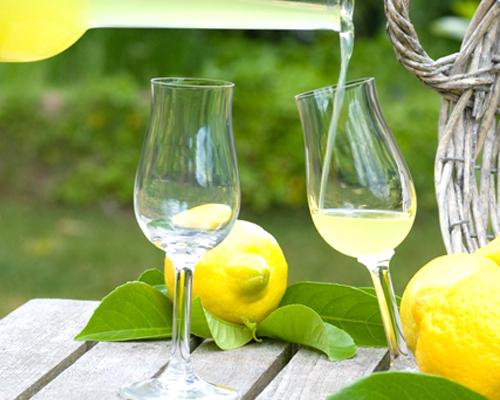Hugging the rocks, it spreads out in just three kilometers on the Amalfi Coast, the second smallest village in Italy.
Conca dei Marini is one of the wonders of the Campania region, a dreamy place nestled in a basin-shaped bay.
The village of Conca dei Marini is a natural inlet jutting out into the sea next to the Fiordo di Furore, an enchanted village with a few hundred inhabitants living in beach houses or white houses clinging to the mountains.
Conca dei Marini: a tale of spirits, caves and sfogliatelle
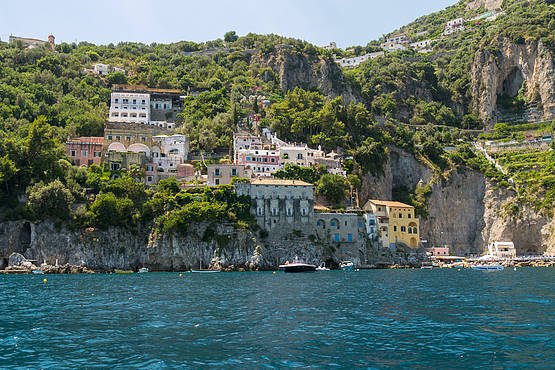
This small village gets its name because of its hollow shape, instead Dei Marini implies proximity to the sea and the sailors’ knowledge of navigation techniques.
It also became a UNESCO World Heritage Site in 1997.
At sea level are the small houses flush with the water that are mirrored in a small bay; high up on the hillside, whitewashed houses scattered among the vegetable gardens, olive groves and lemon terraces that descend below.
All the places in the village are connected by “scalinatelle” (little stairways) that make way for our steps amid the scents of aromatic herbs.
Once Conca dei Marini was only a fishing village, today it also thrives on tourism without losing its collected charm.
Usefull tips
Although it is very small, I highly recommend visiting Conca dei Marini. It is located on the state road Amalfitana 163, between Amalfi and Positano.
By Sita bus it takes about 20 minutes from Amalfi (traffic permitting).
If, on the other hand, you are leaving from Salerno or Positano, I recommend taking the ferry, always passing through Amalfi (from April to October there are many sea lines in operation, fast and punctual).
I do not recommend the car for lack of parking, convenient instead is the scooter (but only if you have practice in driving it, otherwise it could be dangerous).
What to visit in Conca dei Marini
The territory of this village ranges from Capo di Conca, the extreme point on the sea, to the hills that go up towards Agerola and the Monti Lattari. As with other towns on the Amalfi Coast, the historic center is developed away from the sea, so as to protect itself from pirate invasions that were spotted from the towers built on the rocky spurs.
The small village, has as many as six churches: the church dedicated to St. John the Baptist (also known as the church of St. Anthony), erected in the 1200s, the church of St. Pancras, the church of St. Mary of Grado, the church of St. Michael Archangel, and the chapel of the Madonna of the Snow, all built in a panoramic position, as if to protect the village from the Saracens.
Church of St. John the Baptist
For a breathtaking 180-degree view, I recommend you visit this church.
The church of St. John the Baptist stands on a high cliff and overlooks the entire body of water in the basin and serves the faithful of the Penne ward.
The church features a bell tower with a spire vault covered with majolica tiles and a Baroque facade, which features an image of St. Anthony accompanied by the Latin phrase PROTEGAM CIVITATEM ISTAM (“I will protect this city”).
It is very special the color of its facade, during sunset on a clear day, it blends with the red of the sky, thus creating a fiery and breathtaking atmosphere.

The church of the “janare”
The church of St. Pancras Martyr is famous for the legend of the janare.
The “janare”, used to appear, now no more, at night on the olive trees in the hills. Apparently this does not remain just a legend because many people, to this day, testify to having seen such “beings.”
The purely human side of this story is that the spirits were actually women of the village.
Conca dei Marini has always been a village of sailors who stayed at sea for long periods of time. The loneliness of the women, mixed with the rigidity of the customs of the time, is thought to have led some of the wives of these sailors to gather together, wear long white nightgowns, climb the masts and wait at night for the fishermen to come up from the beach, frightening some and attracting the attention of others who were aware of the situation…
Also venerated in the church is Madonna del Carmelo, which is celebrated with a solemn procession on the feast day of July 16.
Near the church is a lookout point directly overlooking the sea, called Punta “Vreca”, because it is shaped like a ship, on which stands a wrought-iron cross.

Monastero di Santarosa
With the bewitching charm of a Dominican convent built in the 17th century, the Santa Rosa Monastery rises majestically over the bay of Conca dei Marini.
A pearl set in an enchanting place, rich in history and tradition that, wonderfully hermit without being isolated, embodies the quintessence of luxury Italian hospitality.
The Monastero di Santa Rosa is a top-notch hotel, but it’s a great option if you want to spend a relaxing day at the spa or have a gastronomic experience with their Michelin-starred restaurant.
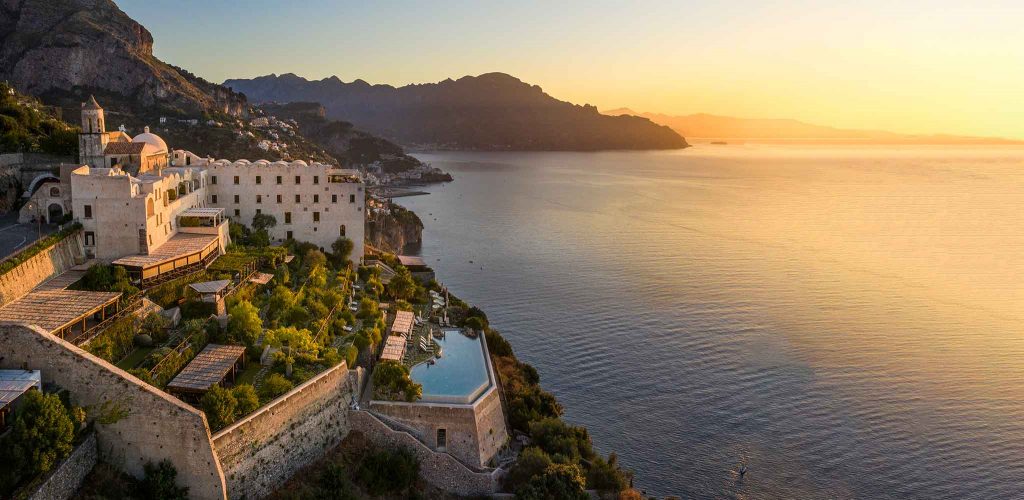


Sfogliatella Santarosa
From the nuns of this ancient monastery, comes the most famous dessert on the Amalfi Coast: sfogliatella Santarosa. You cannot miss it if you visit Conca dei Marini.
Legend has it that this delicious dessert was born by chance in 1681, from the leftovers of a meal, at the Santa Rosa monastery on the heights of the beautiful Conca dei Marini.
The nun in charge of the kitchen found herself grappling with a large amount of leftover semolina and had to engineer to avoid conspicuous food waste.
What to do then but experiment with a good cake with what she had on hand?
So here he soaked the semolina with milk, mixed in ricotta, dried fruit and lemon liqueur (what is known today as Limoncello) and enclosed it all between two sheets of pastry, which he tried to give the shape of a monk’s cap, which he garnished with black cherry and custard.
Thus was born one of the most delicious and successful mixtures in history, named after the saint for whom the monastery was named: Santa Rosa.
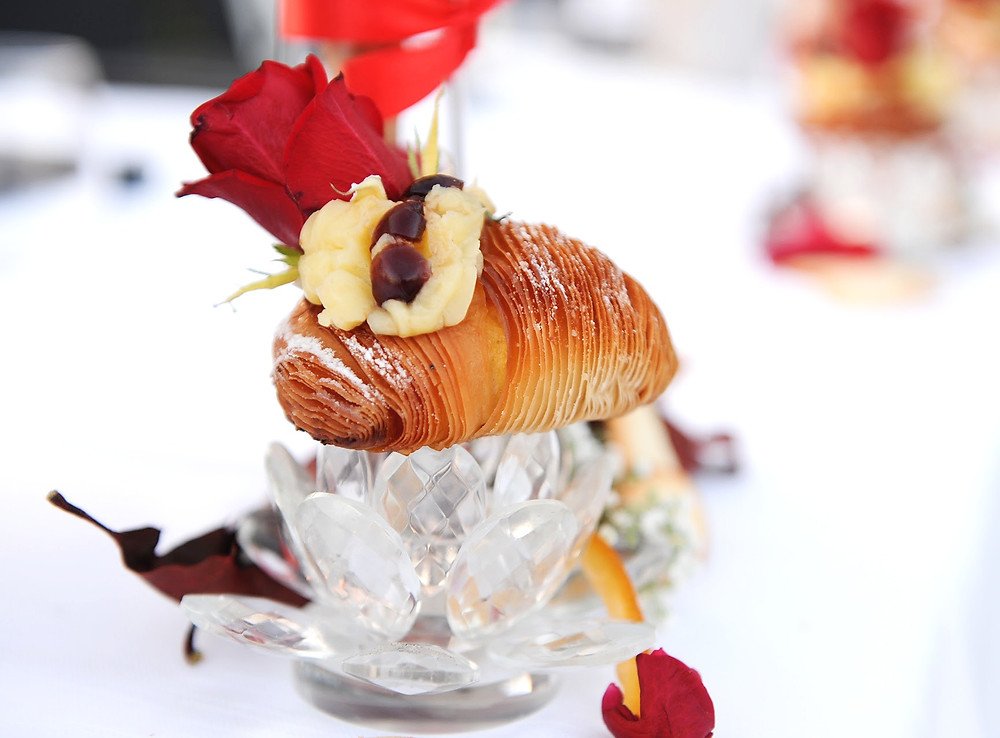
Capo di Conca Tower
The Capo di Conca Tower, also known as the Saracen Tower or the White Tower, is an ancient 16th-century watchtower located on a striking promontory jutting out toward the sea and surrounded by dense Mediterranean scrub vegetation.
It was part of the defensive apparatus of coastal towers of the entire Amalfi Coast, to defend the population from constant pirate raids.
A short hike of about 20 minutes is necessary to get to the Conca dei Marini Tower. There are stairs to get there, so avoid peak hours when it is too hot.
The views are simply stunning. It is definitely a great location to take super photos.
Unfortunately, however, the tower, is only accessible for events.
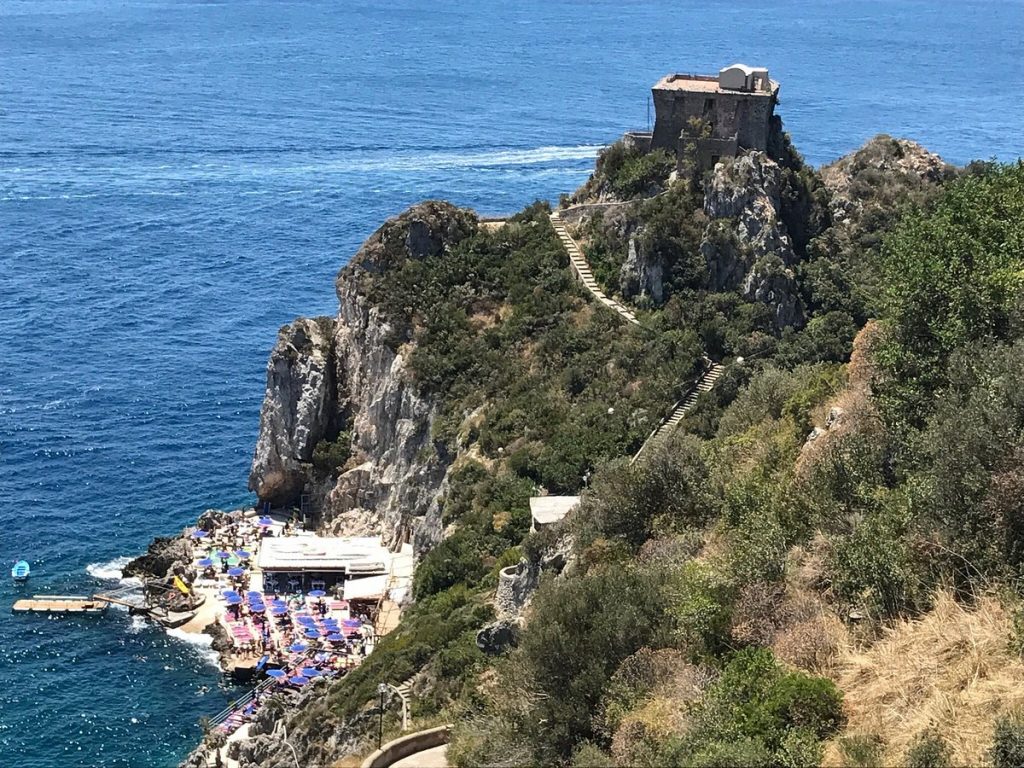
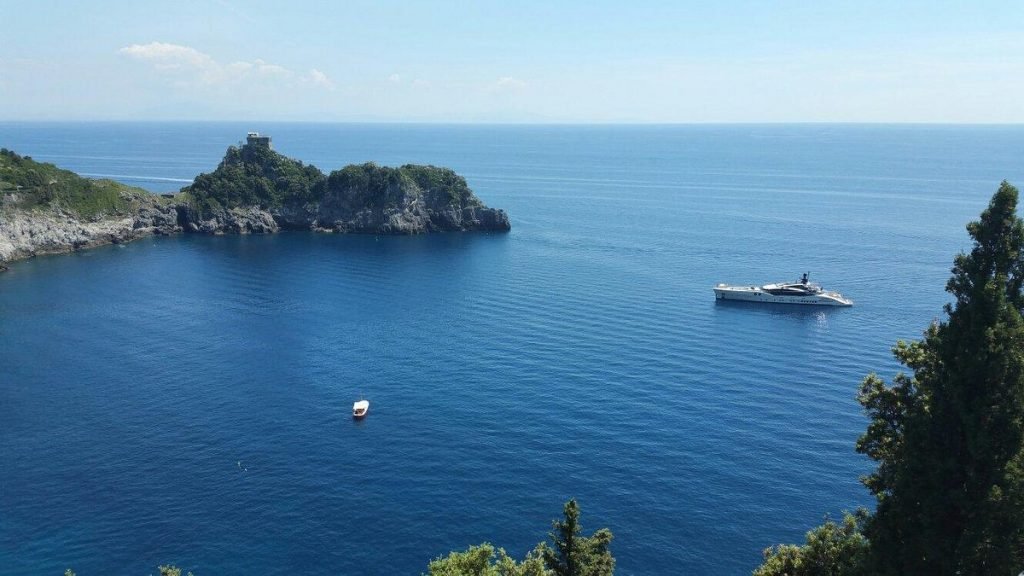
Lido Capo di Conca
As Conca dei Marini is very small, there is only one place to enjoy a day at the beach.
The Lido Capo di Conca is a well-organized bathing establishment that provides its customers with a range of state-of-the-art services upon reservation.
The lido overhangs the sea and the water is very high. Because of this there is a platform for diving but also a children’s pool!
Bar, restaurant, jet ski and boat rentals are the sideshow at this establishment.
To reach it there is also a shuttle service and parking which is arranged by calling, I do not recommend it to people with disabilities however.
As for the hours of sunshine, it is the same as for the fjord of furore, at 3:30 pm shade arrives because of the mountain layout.
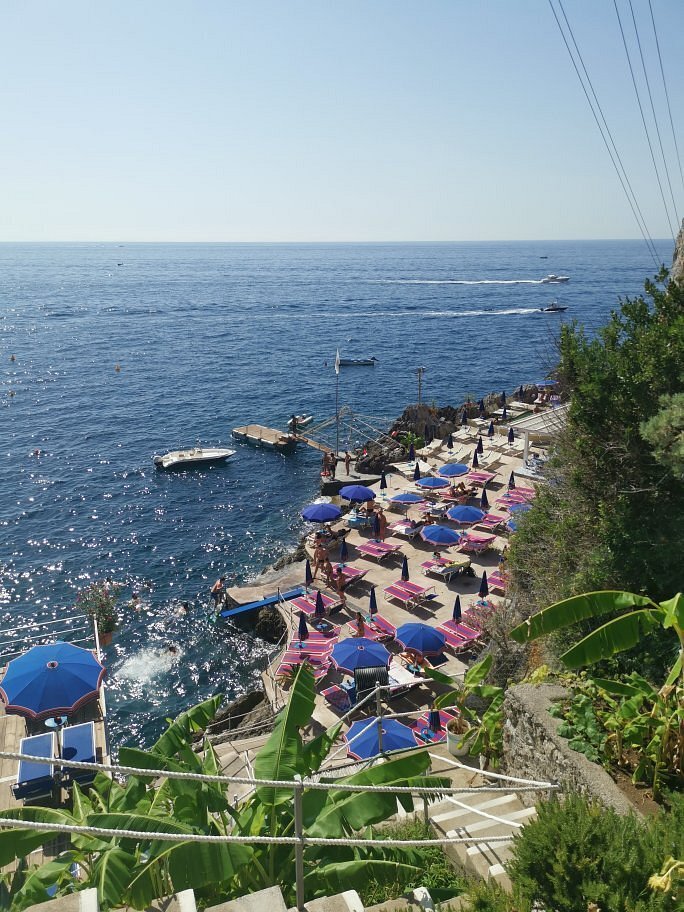

Emerald Grotto
The Emerald Cave in Conca dei Marini is a beautiful natural cave, discovered only 100 years ago, in which rays of light create an emerald green color. Fascinating stalactites and stalagmites create distinctive shapes. Underwater you will also find a white ceramic nativity scene.
An enchanted place, evoking passages from Dante’s “Comedy.” An unspoiled place, mild all year round and well preserved.
Less known and frequented than Capri’s famous Blue Grotto, but no less beautiful for that. Here you will find professional people who will not only conduct the boat in an excellent way but also give you useful explanations and stories about the cave.
Therefore much more stimulating and interesting experience.
The cave can be visited at a cost of 7€ and you can reach it by land (from the state highway or by taking the Sita bus: Conca dei Marini – Grotta stop) and then get off with a free elevator.
By sea with several companies offering round-trip service from Amalfi for about 10€ per person.
The cave during the summer is open until 5:30 pm. However, it is best to go in the middle hours of the day because already by 4 pm the light is scarce. The visit is not long, inside the cave you stay about ten minutes, so it is a short but intense experience.
Arm yourself with the latest cell phone for photos consistent with reality or enjoy the trip and put technology aside!
The final step to your dream vacation in Amalfi Coast!
My goal is to make you experience the same emotions I experience living on the Amalfi Coast.
There are so many jewels to be embedded in the memories of a coastline that leaves its mark on the heart. So many adventures, expectations and dreams.
Be inspired by my stories and write me what is your ideal vacation, what are the emotions you would like to experience, I am sure I can hit the mark by creating the perfect itinerary!
I’ll be waiting for you in the comments!
As always, see you next week!
Brigida 💖


